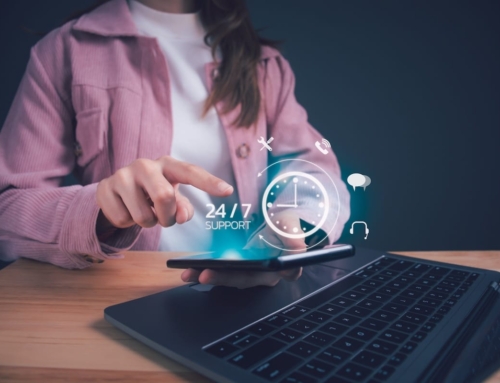Clienteling: Going Beyond Customer Service
Clienteling, customer service, customer care—isn’t it all one and the same?
Short answer: no—and understanding the difference can be make or break for your business.
While it might not seem all that serious, keep in mind that the majority of businesses in 2023 compete mostly or primarily on the basis of customer service. As a result, it’s important to know not just how to nail the customer service aspect of your business, but also how to go beyond customer service to rise above your competition and cement yourself as a true customer advocate.
That’s where clienteling comes in. In this article, you’ll understand what clienteling means in 2023 (hint: it’s not what it used to be!), how it can benefit your company, and get plenty of examples and strategies for doing it well.
What is Clienteling?
Clienteling used to be simple. Simply defined as, “catering to clients,” clienteling in a pre-eCommerce world was pretty straightforward. Clients would come to your store, in-person. Employees would serve the customer, and the customer would eventually form a relationship with store employees, creating loyal customers and a relationship that catered to your client’s needs and desires.
However, in a digital world, clienteling is much more elaborate. Clienteling in 2023 refers to the strategies and processes used to create long-term relationships with customers through customized service, guided selling and other personalization techniques to improve customer satisfaction and loyalty.
Importantly, clienteling needs to span both in-store and online experiences (as applicable), which means that customer data is an essential piece of clienteling in the modern marketplace. Brands who make use of customer purchase histories, behavioral patterns, preferences, demographic data and more will be able to elevate customer relationships and interactions, both online and in-store.
Ultimately, the goal of clienteling is to create a more personalized experience for customers that develops long-term relationships, improves customer satisfaction and increases customer lifetime value.
In practice, clienteling can take one of two forms: directed clienteling or self-directed clienteling.
Directed Clienteling
Directed clienteling involves an interaction between an in-store employee and a client, interfaced by an employee-accessed app that provides them with information on the customer’s past purchases, preferences, online behaviors and more. With this data delivered to the in-store employee’s device, employees can offer the most relevant and personalized recommendations to customers, customizing the experience to be more effective, useful and memorable for the consumer.
Self Directed Clienteling
Alternatively, self-directed clienteling involves a customer-facing app that allows the customer to interact with the brand directly during an in-store experience. Rather than providing an employee with customer demographics and data and allowing the employee to manage the interaction, the interaction is managed via an app by the customer themselves.
Brands may use in-store apps for a variety of purposes, including making product recommendations, advertising in-store discounts or product locations, highlighting product details or reviews, offering coupons, and so on. Self-directed clienteling is highly personalized, as the app’s experience and product recommendations are typically based wholly on the individuals’ data and preferences. Also, because the customer is interacting with the brand and recommendations directly, they can focus on the offers and products most relevant to them.
Benefits of Clienteling
To gain the most benefit from clienteling, brands should integrate their directed and self-directed clienteling, along with both in-store and virtual clienteling. By doing so, brands will be able to deliver seamless, personalized experiences across every stage of the customer journey to gain the best results, including:
- boosting customer satisfaction and loyalty
- improving upselling opportunities and conversions
- increasing customer lifetime value
- building customer trust
- improving customer loyalty and retention over time
How can something as simple as clienteling offer all these benefits? Well, for one, clienteling isn’t really as simple as it sounds—and many brands don’t get it right (making it all the more valuable for brands who do!). Take, for example, that less than half (47%) of brands are currently personalizing customer communications using real-time behavior and customer data.
Ready to take your business to the next level? Let our call center experts show you how we've helped organizations just like yours seamlessly scale while lowering costs and increasing efficiencies.
You won't regret it.
Further, personalization and customer trust are major levers when it comes to customer satisfaction, loyalty, lifetime value, likelihood of purchasing and more. For example:
- 86% of consumers will spend more with companies who personalize their experiences
- 54% of consumers—more than half—expect all of their experiences with a brand to be personalized, with 76% expecting some level of personalization throughout their buying journey
- 59% of consumers prefer personalization even more than speed when it comes to customer service
In addition, more personalized interactions and recommendations induce higher likelihoods of purchase, which improves upselling, cross-selling and repeat purchases—all of which factor into satisfaction, loyalty and retention over time.
Clienteling Tools
Important to keep in mind is that clienteling is not the same as customer service. While customer service may involve some personalized aspects, it’s typically focused on resolving customer concerns or serving the customer in a particular way at a particular point of their journey.
Clienteling, on the other hand, is a multifaceted, data-driven approach towards creating personalized, unique and memorable customer experiences with your brand.
As a result, you may need a particular or expanded set of tools to achieve both goals. While customer service tools typically focus on providing an interface for customer interactions and tracking operational metrics and data, clienteling tools allow you to strengthen your customer relationships through detailed data, seamless access for all of your customer-facing employees and staff, and automated, targeted messaging based on user personas and behavior.
While there’s a variety of companies offering clienteling software—Salesforce, PredictSpring, Lexer—when looking for a clienteling tool, look for the following features and solutions:
Customer profiles
At its most basic, clienteling software provides a solution for keeping all of your customer profiling data in one place—things like demographic and contact info, loyalty program memberships and rewards, preferences, purchase history and so on. When you check out at a store and the employee asks if you want to apply the $5 off coupon you have in your account? That’s great clienteling, thanks to a customer profile.
Access for everyone
With that, a good clienteling solution allows everyone—from in-store associates to customer service agents, your marketing team, management and more—to access and work from the same set of customer data. This means your marketing team can create targeted messaging for user segments, in-store employees can assist shoppers with personalized recommendations based on their data, and customer service employees can quickly see purchase history, in-store interactions and more.
Segmentation analysis
Segmentation analysis allows you to parse out customer profiles into groups based on different data points—whether it be demographic data, location data, behavioral data, preferences or other indicators. Once you’ve segmented customers, segmentation analysis provides you with insights as to which selling strategies, channels, products, messaging or other tactics are most effective for that segment—allowing you to personalize and optimize your outreach at the same time.
For example, which users respond best to abandon cart emails? When is it most effective to reach out to your inactive customers? How long after a product purchase is a customer ready to purchase again? All of these questions and more can be answered through segmentation analysis.
Product insights
For seamless personalized experiences and recommendations, in-store employees should have easy access to product information—including inventory, pricing and promotions, available discounts, product specs, customer reviews, related products, and more. What does any of this have to do with clienteling?
When customers come to your in-store associates, you want your employees to have the full picture of your products and the most complete information to assist your customers. REI is a great example of a brand that has nailed this aspect of clienteling. Recently, when visiting their store to purchase a new sleeping bag, I asked a simple question of an in-store associate about the item I was considering. Not only did he answer my question easily, but he was also able to recommend two similar items, explain how they were different and the benefits of each, and alert me to two sales that were running currently that would apply to several of the items.
In the end, I got the item that was best suited to my needs, managed to score a discount, and REI was able to strengthen their brand trust and perception through my interaction. That’s the power of clienteling!
Examples of Clienteling
Sometimes it’s easiest to lead—or learn—by example. And REI, mentioned above, isn’t the only company using clienteling to their advantage. Consider these other clienteling wins as you implement your own strategy:
Dormify
Dormify has identified and prioritized their niche audience—young adults and students who are living in small spaces (often, dorm rooms) but still want to make their space their own and express themselves through their decor. Beyond just selling bedding and affordable room decor, though, Dormify goes the extra mile to improve customer personalization through clienteling.
How?
Dormify offers several style quizzes and “room visualizers” on their website to enable users to create their dream spaces and wishlists. Dormify then sends users personalized product recommendations based on their results and wishlists. As a result, users are carefully provided with customized recommendations from the very beginning of their customer journey, setting a precedent of personalization and trust.
Nordstroms
Standout clienteling has always been a staple of large department stores, but Nordstroms is one of the best. Not only have they spent decades cultivating a specific in-store experience, but they’ve also established themselves squarely in the digital age as well, creating a seamless virtual and in-person experience.
How?
Through their mobile app, customers can do both virtual and in-person shopping—everything from curating wish lists to reserving dressing rooms or seeing what’s available in-store. Then, the app’s location services alert in-store associates when the customer is on their way if they have a dressing room reservation, allowing employees to get their room set up with their wish list and “must try” items in the client’s preferred sizes, all before the customer even arrives. Talk about service!
Small Businesses
Of course, if you need excellent examples of clienteling, you typically need look no further than your local small businesses. Without the reach or resources of larger corporations, small businesses typically compete wholly on convenience and clienteling—making customer relationships and service a large portion of their success.
Whether it’s the small coffee shop near your house with a barista that always knows your order, a bookstore whose owner makes great recommendations for your kids, or a small restaurant that often throws in an extra side with your order, small business owners have to master the art of clienteling. They often take a more 1:1 approach—forming true relationships between employee and customer, keeping “behind-the-counter” notes, making personalized recommendations from their own experiences, and so on.
Although such a personal approach isn’t scalable—and thus, not always achievable for bigger companies—the theory and method of such an approach is replicable. By keeping your customer relationships at the forefront of your in-store and online customer experiences, you can provide excellent clienteling that leaves your customers feeling seen, valued and satisfied.
When you’re ready to up your clienteling strategy to improve customer loyalty—and your bottom line—it may be time to look outside of what you’re already doing to make improvements. Partnering with a clienteling expert, like our team here at ROI Solutions, is a tried-and-true method for improving customer service, experiences and personalization. Our team can help you develop a strategy, implement new technology and software, improve and personalize customer experiences and stay on top of customer service.
Need help with in-store or virtual customer service and clienteling? Connect with ROI Solutions for world-class, scalable support.






